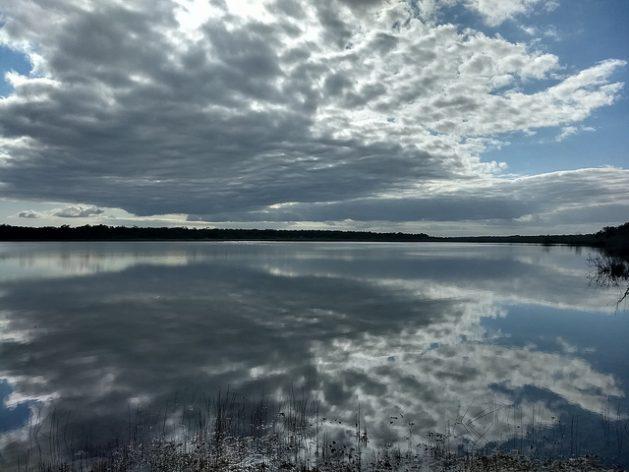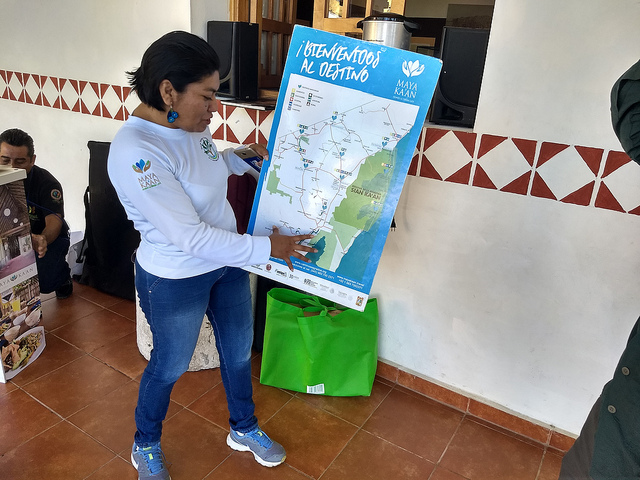
“If thousands of people flock to this town, how will we be able to service them? I’m afraid of that growth,” Zendy Euán, spokeswoman for a community organisation, said in reference to the Mayan Train (TM) project, a railway network that will run through five states in southern Mexico.
Euán, a Mayan indigenous woman living in the municipality of Felipe Carrillo Puerto (FCP), told IPS that they lack detailed information about the megaproject, one of the high-profile initiatives promised during his campaign by the new leftist President Andrés Manuel López Obrador, popularly known by his acronym AMLO.
“It’s not clear to us. We don’t know about the project,” said Euán, who also questioned the benefits promised by the president, who was sworn in on Dec. 1, for the local population, as well as the mechanisms for participation in the project and the threats it poses to the environment.
“What will be the benefit for the local community members, for the craftswomen? As ecotourism communities, will we be able to promote our businesses and goods?” said the spokeswoman for the Community Tourism Network of the Maya Zone of Quintana Roo, one of the states in southeastern Mexico that share the Yucatan Peninsula, on the Atlantic coast, with 1.5 million inhabitants.
The network, launched in 2014, brings together 11 community organisations from three municipalities of Quintana Roo and offers ecotourism and cultural tours in the area, its main economic activity.
In the municipality of FCP, home to just over 81,000 people, there are 84 ejidos,areas of communal land used for agriculture, where community members own and farm their own plots, which can also be sold.
One of them, of the same name as the municipality, FCP, covering 47,000 hectares and belonging to 250 “ejidatarios” or members, manages the ejidal reserves Síijil Noh Há (“where the water flows,” in the Mayan language) and Much’KananK’aax (“let’s take care of the forest together”).
Euán’s doubts are shared by thousands of inhabitants of the peninsula, which receives almost seven million tourists every year.
IPS travelled a stretch of the preliminary TM route through Quintana Roo and the neighboring state of Campeche and noted the general lack of detailed information about the project and its possible ecological, social and cultural consequences in a region with high levels of poverty and social marginalisation.
The government’s National Tourism Fund (Fonatur) is promoting the project, at a cost of between 6.2 and 7.8 billion dollars. The plan is for it to start operating in 2022, with 15 stations along 1,525 kilometers in 41 municipalities in the states of Campeche, Chiapas, Quintana Roo, Tabasco and Yucatán.
The locomotives will run on biodiesel -possibly made from palm oil- and the trains are projected to move about three million passengers annually, in addition to cargo.

Zendy Euán, spokesperson for a community tourism network, explains in the Mayan Museum of the municipality of Felipe Carrillo Puerto, in the state of Quintana Roo, that the Mayan Train will run through key environmental areas of southern Mexico. Social and indigenous organisations question the benefits of the megaproject, one of the star projects of the new president, Andrés Manuel López Obrador. Credit: Emilio Godoy/IPS
The new government argues that the project will boost the region’s socioeconomic development, foster social inclusion and job creation, safeguard indigenous cultures, protect the peninsula’s Protected Natural Areas (PNA), and strengthen the tourism industry.
Ancient ecosystems
The railway will cut through the heart of the Mayan jungle, an ecosystem that formed the base of the Mayan empire that dominated the entire Mesoamerican region – southern Mexico and Central America – from the 8th century until the arrival of the Spanish conquistadors in the 16th century.
This is the most important rainforest in Latin America after the Amazon region and a key area in the conservation of natural wealth in Mexico, which ranks 12th among the most megadiverse countries on the planet.
The region belongs to the Mesoamerican Biological Corridor consisting of habitats running from southern Mexico to Panama, the southernmost of the seven Central American countries, and is home to about 10 percent of the world’s known species.
In the Yucatan Peninsula, shared by the states of Campeche, Quintana Roo and Yucatan, there are 25 PNAs, with a total area of 8.5 million hectares.
In fact, two TM stations will be contiguous to the 725,000-hectare Calakmul Biosphere Reserve and the 650,000-hectare Sian Ka’an Biosphere Reserve.
“What’s going to happen? We don’t know the route, we don’t have information. We have to study this closely,” Luís Tamay, the indigenous president of the Commissariat of Common Assets of the Nuevo Becal ejido in the municipality of Calakmul, in Campeche, told IPS.
Like Euán, Tamay fears the arrival of crowds of tourists, for which Calakmul “is not prepared; this is a high-impact project” for a municipality of just over 28,000 people.
Nuevo Becal has 84 landowners, covers 52,800 hectares and carries out six projects of timber exploitation, agroforestry, seeds and environmental conservation.
Although the TM will not pass through the immediate vicinity of Nuevo Becal, the megaproject will have impacts on the area.
In Calakmul, the government will carry out technical and environmental impact studies in 2019, with the idea of starting construction the following year in the locality.
To build the railway network, the government must negotiate with the ejidatarios, who own most of the land in the five states along the planned railway, as there are 385 in Campeche, 279 in Quintana Roo and 737 in Yucatán.
The government has already asked for 30 hectares in the Felipe Carrillo Puerto ejido to build a station, as a contribution to the project, which was first proposed in 2007 by the then governor of Yucatan, Yvonne Ortega, who projected the Transpeninsular Rapid Train in 2007.
Shortly after taking office in December 2012, AMLO’s predecessor, conservative Enrique Peña Nieto, adopted it as a national plan to connect the region. But public spending cutbacks in 2015 put the project on hold.
To the original project which will be added more than 300 kilometers of rundown railroads that functioned between 1905 and 1957, first for military transport and then also for passenger traffic.
On Nov. 24-25, before AMLO took office, his team obtained support for the railway network, along with a new refinery in the state of Tabasco and the execution of other projects, during a National Consultation on 10 Priority Social Programmes.
But this support, in a consultation that was only carried out in certain localities through a process that was not very representative, did not appease the criticism of the TM in the region.
On Nov. 15, a group of academics asked López Obrador to stop the works because of their ecological, social, cultural and archaeological impacts.
Three days later, a collective of indigenous organisations rejected the project, demanded respect for their forests and jungles, and called for free, prior, informed and culturally appropriate consultation.
“They are violating our indigenous rights. We don’t agree with how the consultation was carried out, and we don’t see the benefits for the local communities. This is aimed at tourist spots. Those who will benefit are the big businesses” in the sector, Miguel Ku, representative of the Network of Environmental Service Producers, told IPS.
This organization brings together 3,756 ejidatarios from 33 agrarian communities in the municipality of José María Morelos, and three more in the municipality of FCP, all of which are in Quintana Roo. Together, they own 257,000 hectares that are used for forestry, agriculture, beekeeping and livestock.
Local organisations are seeking another socioeconomic model. “We have shown that conservation allows for good development. We have natural resources, let us take advantage of them, that’s how we can support ourselves,” said Tamay.
Ku protested what he called a repeat of what has happened with previous projects. “We are sick and tired of others taking the benefits even though we own the land. The government could do something else. We want the ejidos to develop their own projects,” he said.
But López Obrador appears to be in a hurry to move forward with the Mayan Train, and on Dec. 16 he laid the first stone in the city of Palenque, Chiapas, without waiting for Fonatur to present the environmental impact assessment to the environment ministry.
